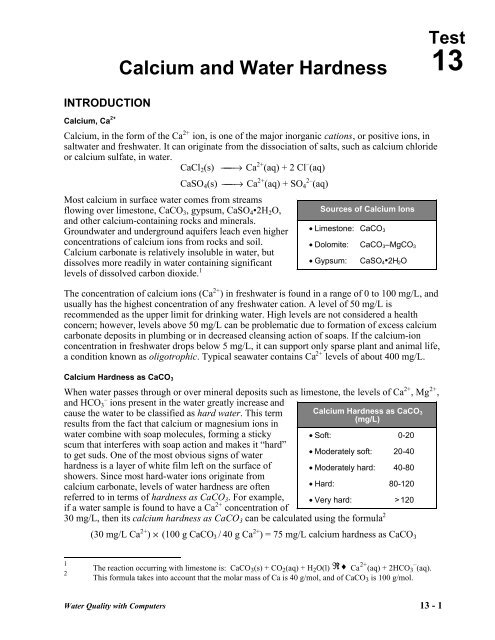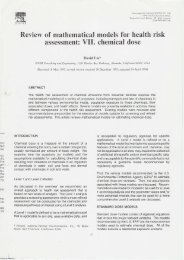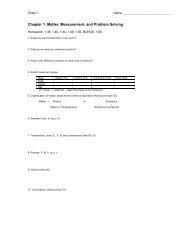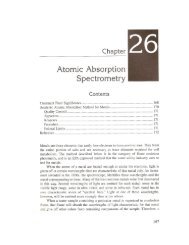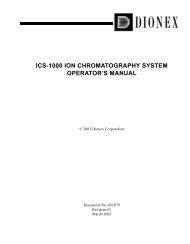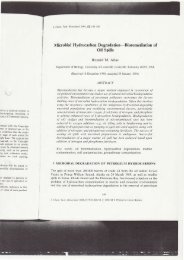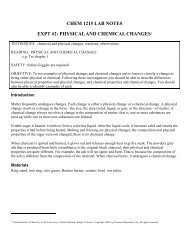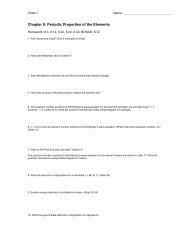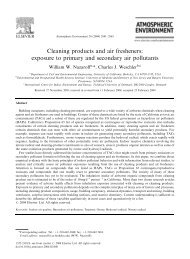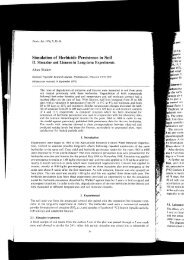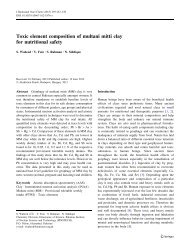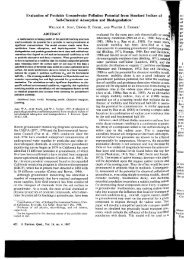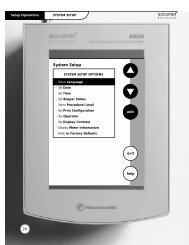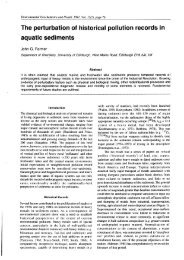Calcium and Water Hardness
Calcium and Water Hardness
Calcium and Water Hardness
You also want an ePaper? Increase the reach of your titles
YUMPU automatically turns print PDFs into web optimized ePapers that Google loves.
<strong>Calcium</strong> <strong>and</strong> <strong>Water</strong> <strong>Hardness</strong><br />
Test<br />
13<br />
INTRODUCTION<br />
<strong>Calcium</strong>, Ca 2+<br />
<strong>Calcium</strong>, in the form of the Ca 2+ ion, is one of the major inorganic cations, or positive ions, in<br />
saltwater <strong>and</strong> freshwater. It can originate from the dissociation of salts, such as calcium chloride<br />
or calcium sulfate, in water.<br />
CaCl 2 (s) ⎯→⎯ Ca 2+ (aq) + 2 Cl Ð (aq)<br />
CaSO 4 (s) ⎯→⎯ Ca 2+ (aq) + SO 2Ð 4 (aq)<br />
Most calcium in surface water comes from streams<br />
flowing over limestone, CaCO 3 , gypsum, CaSO 4 ¥2H 2 O, Sources of <strong>Calcium</strong> Ions<br />
<strong>and</strong> other calcium-containing rocks <strong>and</strong> minerals.<br />
Groundwater <strong>and</strong> underground aquifers leach even higher • Limestone: CaCO 3<br />
concentrations of calcium ions from rocks <strong>and</strong> soil.<br />
• Dolomite: CaCO 3 ÐMgCO 3<br />
<strong>Calcium</strong> carbonate is relatively insoluble in water, but<br />
dissolves more readily in water containing significant • Gypsum: CaSO 4 ¥2H 2 O<br />
levels of dissolved carbon dioxide. 1<br />
The concentration of calcium ions (Ca 2+ ) in freshwater is found in a range of 0 to 100 mg/L, <strong>and</strong><br />
usually has the highest concentration of any freshwater cation. A level of 50 mg/L is<br />
recommended as the upper limit for drinking water. High levels are not considered a health<br />
concern; however, levels above 50 mg/L can be problematic due to formation of excess calcium<br />
carbonate deposits in plumbing or in decreased cleansing action of soaps. If the calcium-ion<br />
concentration in freshwater drops below 5 mg/L, it can support only sparse plant <strong>and</strong> animal life,<br />
a condition known as oligotrophic. Typical seawater contains Ca 2+ levels of about 400 mg/L.<br />
<strong>Calcium</strong> <strong>Hardness</strong> as CaCO 3<br />
When water passes through or over mineral deposits such as limestone, the levels of Ca 2+ , Mg 2+ ,<br />
<strong>and</strong> HCO Ð 3 ions present in the water greatly increase <strong>and</strong><br />
cause the water to be classified as hard water. This term <strong>Calcium</strong> <strong>Hardness</strong> as CaCO 3<br />
(mg/L)<br />
results from the fact that calcium or magnesium ions in<br />
water combine with soap molecules, forming a sticky • Soft: 0-20<br />
scum that interferes with soap action <strong>and</strong> makes it ÒhardÓ<br />
to get suds. One of the most obvious signs of water<br />
• Moderately soft: 20-40<br />
hardness is a layer of white film left on the surface of • Moderately hard: 40-80<br />
showers. Since most hard-water ions originate from<br />
calcium carbonate, levels of water hardness are often • Hard: 80-120<br />
referred to in terms of hardness as CaCO 3 . For example,<br />
if a water sample is found to have a Ca 2+ • Very hard: > 120<br />
concentration of<br />
30 mg/L, then its calcium hardness as CaCO 3 can be calculated using the formula 2<br />
(30 mg/L Ca 2+ ) 5 (100 g CaCO 3 / 40 g Ca 2+ ) = 75 mg/L calcium hardness as CaCO 3<br />
1<br />
2<br />
The reaction occurring with limestone is: CaCO 3 (s) + CO 2 (aq) + H 2 O(l) R ♦ Ca 2+ –<br />
(aq) + 2HCO 3 (aq).<br />
This formula takes into account that the molar mass of Ca is 40 g/mol, <strong>and</strong> of CaCO 3 is 100 g/mol.<br />
<strong>Water</strong> Quality with Computers 13 - 1
Ca 2+<br />
Test 13<br />
Note that 30 mg/L Ca 2+ <strong>and</strong> 75 mg/L calcium hardness as CaCO 3 are equivalentÑthey are<br />
simply two different ways of expressing calcium levels. The value of calcium hardness as CaCO 3<br />
can always be obtained by multiplying the Ca 2+ concentration by a factor of 100/40, orÊ2.5.<br />
Another common measurement of water hardness is known as total hardness as CaCO 3 . This<br />
measurement takes into account both Ca 2+ <strong>and</strong> Mg 2+ ions. On average, magnesium hardness<br />
represents about 1/3 of total hardness <strong>and</strong> calcium hardness about 2/3. If you are comparing your<br />
own test results of calcium hardness as CaCO 3 with results in publications that use units of total<br />
hardness as CaCO 3 , you can estimate total hardness by multiplying the calcium hardness<br />
by 1.5. See Test 14, Total <strong>Water</strong> <strong>Hardness</strong>, for further information about this topic.<br />
Expected Levels<br />
The concentration of calcium ions (Ca 2+ ) in freshwater is found in a range of 4 to 100 mg/L<br />
(10 Ð250 mg/L of calcium hardness as CaCO 3 ). Seawater contains calcium levels of 400<br />
mg/LÊCa 2+ (1000 mg/L of calcium hardness as CaCO 3 ).<br />
Table 1: <strong>Calcium</strong>, <strong>Calcium</strong> <strong>Hardness</strong>, <strong>and</strong> Total <strong>Hardness</strong> in Selected Sites<br />
Site (fall season)<br />
<strong>Calcium</strong><br />
(mg/L Ca 2+ )<br />
Ca hardness Total hardness<br />
(mg/L as CaCO 3 ) (mg/L as CaCO 3 )<br />
Merrimack River, Lowell, NH 6.3 15.8 20.8<br />
Mississippi River, Memphis, TN 48.0 120.0 178.3<br />
Rio Gr<strong>and</strong>e River, El Paso, TX 84.0 210.0 297.5<br />
Ohio River, Gr<strong>and</strong> Chain, OH 24.0 60.0 86.3<br />
Willamette River, Portl<strong>and</strong>, OR 6.4 16.0 25.2<br />
Missouri River, Garrison Dam, ND 53.0 132.5 215.8<br />
Sacramento River, Keswick, CA 11.0 27.5 46.3<br />
Hudson River, Poughkeepsie, NY 26.0 65.0 84.6<br />
Platte River, Louisville, NE 72.0 180.0 250.8<br />
Colorado River, Andrade, CA 76.0 190.0 294.2<br />
Summary of Method<br />
A Vernier <strong>Calcium</strong> Ion-Selective Electrode (ISE) is used to measure the calcium ion<br />
concentration in the water, in mg/L as Ca 2+ , either on site or after returning to the lab. This value<br />
is then multiplied by a factor of 2.5 to obtain a value for calcium hardness as CaCO 3 , in mg/L.<br />
13 - 2 <strong>Water</strong> Quality with Computers
<strong>Calcium</strong> <strong>and</strong> <strong>Water</strong> <strong>Hardness</strong><br />
CALCIUM ION-SELECTIVE ELECTRODE<br />
Ca 2+<br />
Materials Checklist<br />
___ laptop computer (Power Mac or Windows) ___ Low St<strong>and</strong>ard (10 mg/L Ca 2+ )<br />
___ Vernier computer interface, battery-powered ___ High St<strong>and</strong>ard (1000 mg/L Ca 2+ )<br />
___ Logger Pro<br />
___ wash bottle with distilled water<br />
___ Vernier ISE Amplifier<br />
___ tissues<br />
___ <strong>Calcium</strong> Ion-Selective Electrode<br />
___ small paper or plastic cup (optional)<br />
Advanced Preparation<br />
The Vernier <strong>Calcium</strong> Ion-Selective Electrode (ISE) must be soaked in the<br />
<strong>Calcium</strong> High St<strong>and</strong>ard solution (included with the ISE) for approximately 30<br />
minutes. Important: Make sure the ISE is not resting on the bottom, <strong>and</strong> that the<br />
small white reference contacts are immersed. Make sure no air bubbles are<br />
trapped below the ISE.<br />
If the ISE needs to be transported to the field during the soaking process, use the<br />
ISE soaking bottle included with the ISE. Remove the cap from the ISE soaking<br />
bottle <strong>and</strong> fill the bottle 3/4 full with High St<strong>and</strong>ard. Slide the cap onto the<br />
electrode, insert it into the bottle, <strong>and</strong> tighten. Important: Do not leave the ISE<br />
soaking for more than 24Êhours. Long-term storage should be in a dry<br />
environment.<br />
ISE soaking<br />
for travel<br />
Collection <strong>and</strong> Storage of Samples<br />
1. This test can be conducted on site or in the lab. A 100-mL water sample is required.<br />
2. It is important to obtain the water sample from below the surface of the water <strong>and</strong> as far away<br />
from shore as is safe. If suitable areas of the stream appear to be unreachable, samplers<br />
consisting of a rod <strong>and</strong> container can be constructed for collection. Refer to page Intro-4 of<br />
the Introduction of this book for more details.<br />
Testing Procedure<br />
1. Position the computer safely away from the water. Keep water away from the computer at all<br />
times.<br />
2. Prepare the computer for data collection by opening ÒTest 13 <strong>Calcium</strong> <strong>and</strong> <strong>Hardness</strong>Ó from<br />
the <strong>Water</strong> Quality with Computers experiment files of Logger Pro. On the Graph window, the<br />
vertical axis has calcium concentration scaled from 0 to 100 mg/L Ca 2+ . The horizontal axis<br />
has time scaled from 0 to 10 seconds. There is also a Meter window which displays live<br />
calcium concentration readings.<br />
<strong>Water</strong> Quality with Computers 13 - 3
Ca 2+<br />
3. Prepare the <strong>Calcium</strong> Ion-Selective Electrode (ISE) for data collection.<br />
a. The ISE should be soaking in the High St<strong>and</strong>ard. Make sure that it is not resting on the<br />
bottom of the container, <strong>and</strong> that the small white reference contacts are immersed.<br />
b. Plug the ISE Amplifier into the Port 1 or Channel 1 of the Vernier computer interface.<br />
Connect the <strong>Calcium</strong> ISE to the ISE Amplifier.<br />
4. You are now ready to prepare the computer <strong>and</strong> <strong>Calcium</strong> ISE for calibration.<br />
First Calibration Point<br />
a. Choose Calibrate from the Experiment menu <strong>and</strong> then click .<br />
b. Type Ò1000Ó (the concentration in mg/LÊCa 2+ ) in the edit box.<br />
c. When the displayed voltage reading for Input 1 stabilizes, click Keep .<br />
Test 13<br />
Second Calibration Point<br />
d. Rinse the ISE thoroughly with distilled water <strong>and</strong> gently blot it dry with a tissue. Be very<br />
gentle when blotting the membrane. Important: Failure to carefully rinse <strong>and</strong> dry the ISE<br />
will contaminate the st<strong>and</strong>ard.<br />
e. Place the tip of the ISE into the Low St<strong>and</strong>ard (10 mg/L Ca 2+ ). Be sure that the ISE is not<br />
resting on the bottom of the bottle <strong>and</strong> that the small white reference contacts are<br />
immersed. Make sure no air bubbles are trapped below the ISE.<br />
f. After briefly swirling the solution, hold the ISE still <strong>and</strong> wait approximately 30 seconds<br />
for the voltage reading displayed on the computer screen to stabilize.<br />
g. Enter Ò10Ó (the concentration in mg/LÊCa 2+ ) in the edit box.<br />
h. When the displayed voltage reading for Input 1 stabilizes, click Keep , then click OK .<br />
5. You are now ready to collect calcium concentration data.<br />
a. Rinse the ISE with distilled water <strong>and</strong> gently blot it dry.<br />
b. Place the tip of the probe into the stream at Site 1, or into a cup with sample water from<br />
the stream. Make sure the ISE is not resting on the bottom <strong>and</strong> that the small white<br />
reference contacts are immersed. Make sure that no air bubbles are trapped below the ISE.<br />
c. After briefly swirling the solution, hold the ISE still <strong>and</strong> wait approximately 30 seconds.<br />
d. If the calcium concentration value appears stable, simply record it on the Data &<br />
Calculations sheet <strong>and</strong> proceed to Step 7.<br />
6. If the calcium concentration value displayed in the Meter window is fluctuating, determine<br />
the mean (or average) value. To do this:<br />
a. Click Collect to begin a 10-second sampling run. Important: Leave the probe tip<br />
submerged for the 10 seconds that data is being collected.<br />
b. Click on the Statistics button,Ê , to display the statistics box on the graph.<br />
c. Record the mean calcium concentration value on the Data & Calculations sheet.<br />
7. Return to Step 5 to obtain a second reading.<br />
8. Convert the calcium concentration (mg/L Ca 2+ ) to units of calcium hardness (mg/L as<br />
CaCO 3 ). The calculation takes into account the difference in the molar masses of calcium<br />
(40Êg/mol Ca 2+ ) <strong>and</strong> calcium carbonate (100 g/mol CaCO 3 ). To convert to units of calcium<br />
hardness, perform the following calculation:<br />
calcium hardness as CaCO 3 = (mg/L Ca 2+ ) 5 (100 g CaCO 3 / 40 g Ca 2+ )<br />
= (mg/L Ca 2+ ) 5 2.5<br />
Record this value on the Data & Calculations sheet (round to the nearest 0.01 mg/L).<br />
13 - 4 <strong>Water</strong> Quality with Computers
<strong>Calcium</strong> <strong>and</strong> <strong>Water</strong> <strong>Hardness</strong><br />
DATA & CALCULATIONS<br />
<strong>Calcium</strong> <strong>and</strong> <strong>Calcium</strong> <strong>Hardness</strong><br />
Stream or lake: ___________________________<br />
Site name: ______________________________<br />
Site number: ____________________________<br />
Date: __________________________________<br />
Ca 2+<br />
Time of day: __________________________<br />
Student name: ________________________<br />
Student name: ________________________<br />
Student name: ________________________<br />
A<br />
B<br />
Reading<br />
<strong>Calcium</strong><br />
(mg/L Ca 2+ )<br />
<strong>Calcium</strong> hardness<br />
(mg/L CaCO 3 )<br />
1<br />
2<br />
Average<br />
Column Procedure:<br />
A. Record the calcium concentration (mg/L Ca 2+ ) from the computer.<br />
B. Multiply calcium concentration (mg/L Ca 2+ ) by 2.5 to obtain calcium hardness (as CaCO 3 ).<br />
Field Observations (e.g., weather, geography, vegetation along stream) _________________________<br />
_____________________________________________________________________________<br />
_____________________________________________________________________________<br />
_____________________________________________________________________________<br />
Test Completed: ________________ Date: ______<br />
<strong>Water</strong> Quality with Computers 13 - 5
Ca 2+<br />
ADDITIONAL INFORMATION<br />
Test 13<br />
Tips for Instructors<br />
1. The range of the <strong>Calcium</strong> Ion-Selective Electrode is 0.20 to 40,000 mg/L Ca 2+ . As stated in<br />
the introduction, most values you measure from streams <strong>and</strong> lakes will be in the range of 4 to<br />
100 mg/LÑthe lower end of the useful range of the sensor. <strong>Calcium</strong> hardness is found in the<br />
range of 10 to 250 mg/L as CaCO 3 .<br />
2. Two st<strong>and</strong>ard solutions are included with the <strong>Calcium</strong> ISEÑa High St<strong>and</strong>ard that is<br />
1000Êmg/L, <strong>and</strong> a Low St<strong>and</strong>ard that is 10 mg/L. 3 You can replace the st<strong>and</strong>ards using these<br />
directions:<br />
High St<strong>and</strong>ard (1000 mg/L Ca 2+ )<br />
a. Add 2.771 g of CaCl 2 (or 3.669 g of CaCl 2 ¥2H 2 O) to enough distilled water to prepare<br />
oneÊliter of solution.<br />
Low St<strong>and</strong>ard (10 mg/L Ca 2+ )<br />
b. Dilute the High St<strong>and</strong>ard from 1000 mg/L to 100 mg/L by combining 100 mL of the High<br />
St<strong>and</strong>ard with 900 mL of distilled water. Mix well.<br />
c. Combine 100 mL of the 100-mg/L solution with 900 mL of distilled water. Mix well. This<br />
st<strong>and</strong>ard is now 10 mg/L Ca 2+ .<br />
3. The <strong>Calcium</strong> ISE can be used in a wide range of pH values, pH 3 to 10. The ions that are<br />
known to interfere with the <strong>Calcium</strong> ISE (Pb 2+ , Hg 2+ , Sr 2+ , Cu 2+ , Ni 2+ ) will not generally be<br />
encountered in significant concentrations in freshwater samples.<br />
4. Even better results can be obtained if you bring all samples to the same ionic strength. This is<br />
especially important when working with very low concentrations of ions. This can be<br />
accomplished by the addition of ionic strength adjuster, ISA. Add <strong>Calcium</strong> ISA in the ratio of<br />
approximately 1 to 50; for example, if your water sample is 50 mL in volume, add about<br />
1ÊmL of ISA.<br />
A bottle of <strong>Calcium</strong> ISA solution was provided with <strong>Calcium</strong> Ion-Selective Electrodes prior<br />
to 1999. To prepare 100 mL of <strong>Calcium</strong> ISA solution, 1.0 M KCl, add 7.46 g of solid<br />
potassium chloride, KCl, to enough water to prepare 100 mL of solution.<br />
5. Soaking your ISE prior to use is very important. The Advanced Preparation section<br />
recommends approximately 30 minutes of soaking in the High St<strong>and</strong>ard solution. This is<br />
usually sufficient, but an hour-long soak is even better. If you are going out into the field,<br />
you can Òsoak as you goÓ using the ISE Soaking Bottle. We began shipping ISE Soaking<br />
Bottles with Vernier Ion-Selective Electrodes in January of 1999. If you purchased your ISEs<br />
prior to this <strong>and</strong> would like to use ISE Soaking Bottles, they can be purchased from Vernier<br />
Software (BTL-ISE, $10 per package of 5 bottles). Important: Do not let the ISE soak<br />
longer than 24 hours. ISEs are designed to be stored dry.<br />
6. The <strong>Calcium</strong> ISE has a PVC membrane with a limited life expectancy. It is warranted to be<br />
free from defects for a period of twelve (12) months from the date of purchase; it is possible,<br />
however, that you may get somewhat longer use than the warranty period. If you start to<br />
3<br />
Prior to 1999, the Low St<strong>and</strong>ard Solution shipped with each <strong>Calcium</strong> ISE was 100 mg/L Ca 2+ . This<br />
st<strong>and</strong>ard can<br />
be diluted to 10 mg/L by carefully measuring out 10 mL of the 100 mg/L st<strong>and</strong>ard, <strong>and</strong> adding enough distilled<br />
water (~90 mL) to make 100 mL of 10 mg/L st<strong>and</strong>ard.<br />
13 - 6 <strong>Water</strong> Quality with Computers
<strong>Calcium</strong> <strong>and</strong> <strong>Water</strong> <strong>Hardness</strong><br />
notice a reduced response (e.g., distinctly different voltages or voltage ranges during<br />
calibration), it is probably time to replace the membrane module. Important: Do not order<br />
membrane modules far in advance of the time you will be using them; the process of<br />
degradation takes place even when they are stored dry on the shelf.<br />
Ca 2+<br />
How the <strong>Calcium</strong> Ion-Selective Electrode Works<br />
The <strong>Calcium</strong> Ion-Selective Electrode is a membrane-based electrode that measures calcium ions<br />
in an aqueous solution. The membrane is a porous plastic disk, permeable to the ion exchanger,<br />
but impermeable to water. When the membrane of the ISE is in contact with a solution<br />
containing the calcium ion, a voltage, dependent on the level of calcium in the solution, develops<br />
at the membrane. Logger Pro reads the voltage <strong>and</strong> calculates the ion concentration.<br />
<strong>Water</strong> Quality with Computers 13 - 7


